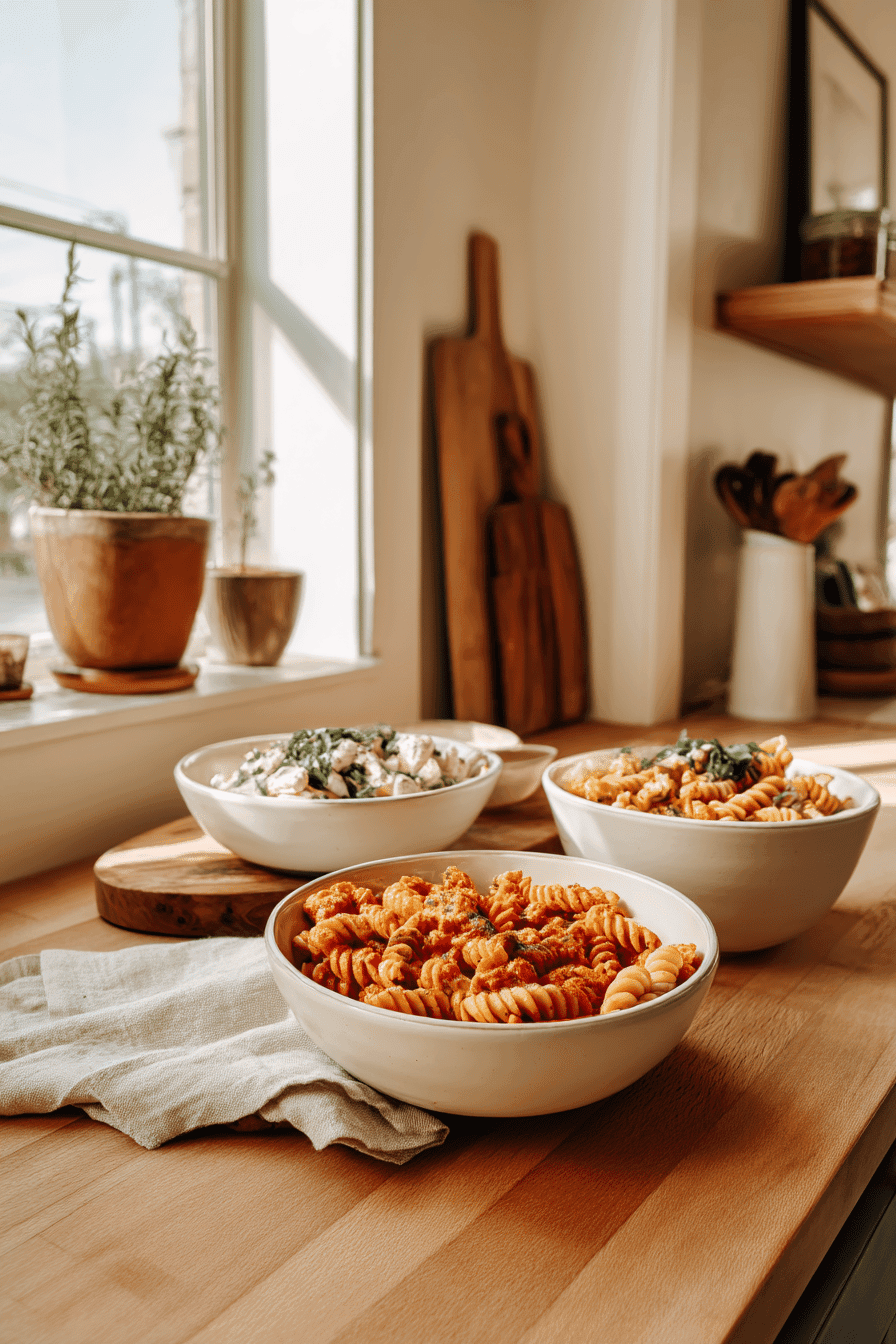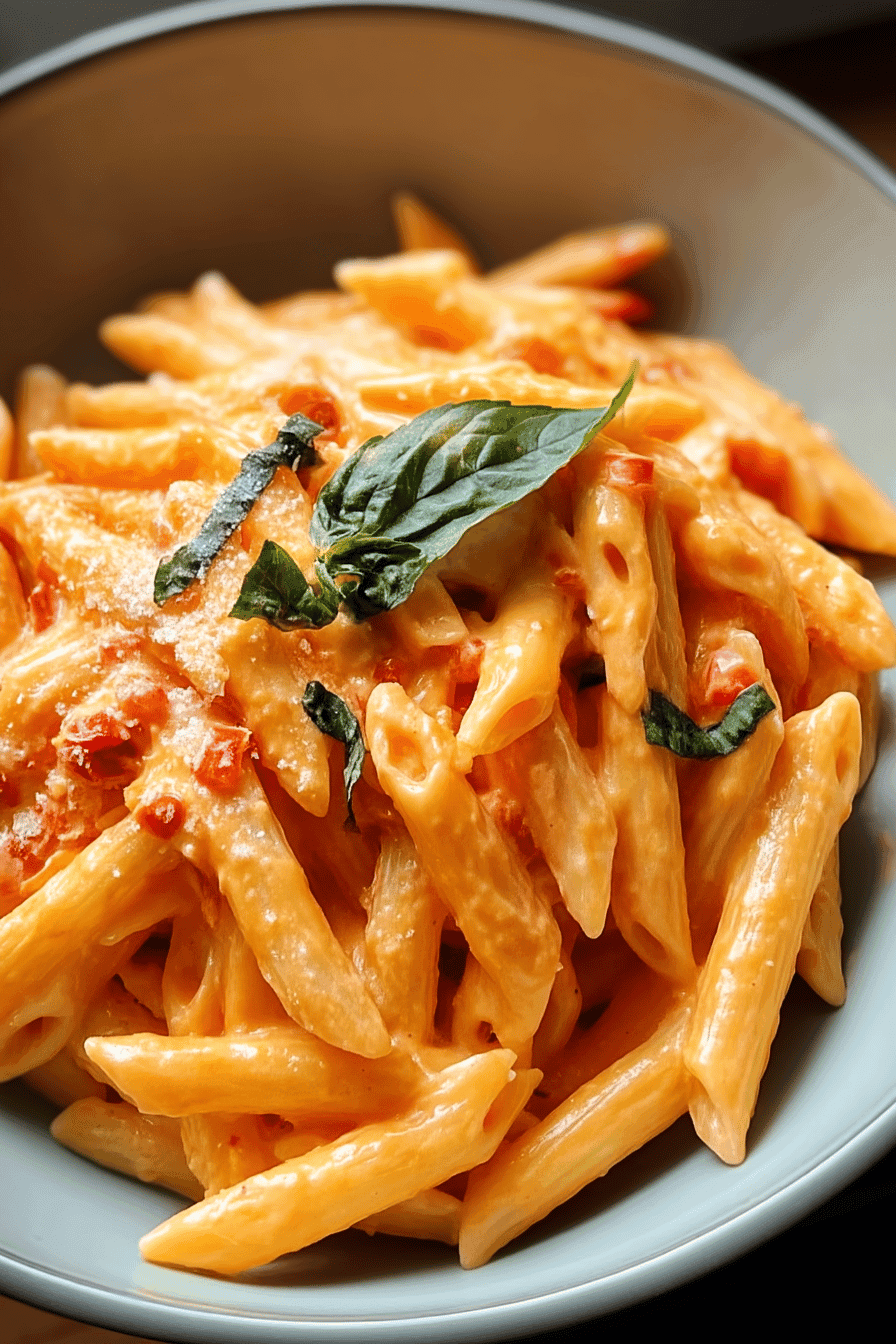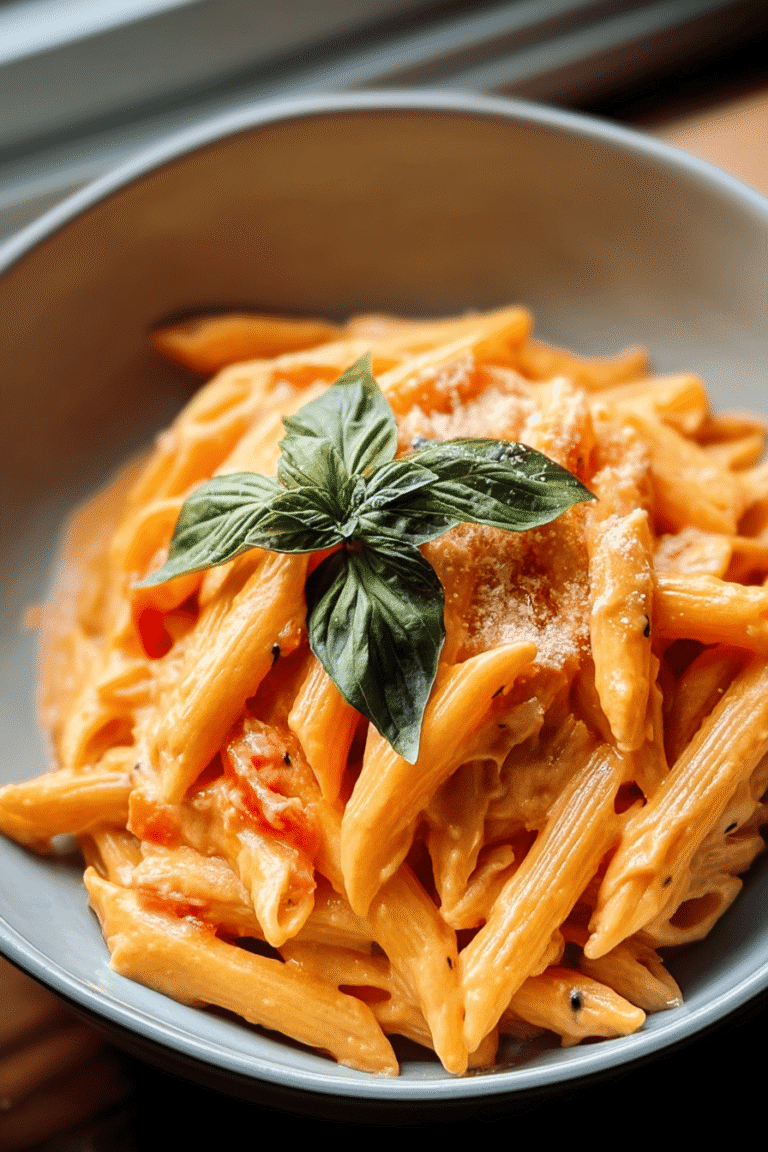Benefits and Advantages of Creamy Tomato Basil Pasta
This creamy tomato basil pasta recipe is known for its quick and simple preparation, making it perfect for busy weeknight dinners or cooks new to Italian-style dishes. It highlights fresh summer tomatoes and fragrant basil, combining a rich creaminess with herbal freshness to create a flavor profile that is both indulgent and light.
The dish stands out because it balances comforting textures with wholesome ingredients, providing a satisfying meal without heaviness. It’s also highly adaptable, able to accommodate a variety of diets such as vegan and gluten-free without losing its distinctive appeal.
From a nutritional perspective, the fresh tomatoes and basil supply antioxidants and vitamins, while the creamy sauce offers richness that complements the naturally savory notes. This combination of simplicity, taste, and healthfulness makes creamy tomato basil pasta a go-to recipe for food enthusiasts looking for an easy yet gourmet meal.
“The marriage of fresh basil and ripe tomatoes in a creamy sauce is a timeless pairing that’s both nourishing and comforting.”
Jump to:
- Benefits and Advantages of Creamy Tomato Basil Pasta
- Essential Ingredients for Creamy Tomato Basil Pasta
- Dietary Substitutions to Customize Your Creamy Tomato Basil Pasta
- Dairy-Free and Vegan Options
- Gluten-Free Choices
- Low-Calorie Variations
- Flavor Adjustments
- How to Prepare the Perfect Creamy Tomato Basil Pasta: Step-by-Step Guide
- Step 1: Cook the Pasta
- Step 2: Sauté Aromatics
- Step 3: Create the Base Sauce
- Step 4: Build Creamy Sauce
- Step 5: Incorporate Cheese and Basil
- Step 6: Finish and Serve
- Mastering Creamy Tomato Basil Pasta: Advanced Tips and Variations
- How to Store Creamy Tomato Basil Pasta: Best Practices
- Refrigeration
- Freezing
- Tips for Reheating
- Nutritional Value of Creamy Tomato Basil Pasta
- FAQs: Frequently Asked Questions About Creamy Tomato Basil Pasta
- Can I use canned crushed tomatoes instead of fresh tomatoes for creamy tomato basil pasta?
- What types of pasta work best for creamy tomato basil pasta?
- Is it possible to add protein to creamy tomato basil pasta, and what are good options?
- How much fresh basil should I add, and can I substitute dried basil?
- Should I save pasta water when making creamy tomato basil pasta, and why?
- Rich and Creamy Tomato Basil Pasta Recipe for Easy Weeknight Dinners
- Ingredients
- Instructions
- Last Step:
- Notes
- Nutrition
- Did you make this recipe?
Essential Ingredients for Creamy Tomato Basil Pasta
To prepare creamy tomato basil pasta, you will need the following ingredients, carefully chosen for flavor and texture:
- 8 ounces (about 225 g) uncooked pasta (shells, cavatappi, or your preferred shape; ravioli or tortellini can also be used)
- 2 to 4 tablespoons butter (adjust for richness)
- ½ yellow onion, diced (optional, adds subtle sweetness)
- 3 to 4 cloves garlic, minced
- ¼ cup dry white wine (such as pinot grigio or sauvignon blanc) or substitute with chicken or vegetable broth
- 15 ounces (about 425 g) tomato sauce or 3 ounces (85 g) tomato paste, based on preference
- 1 cup heavy or whipping cream
- ½ tablespoon all-purpose flour (optional, for making a roux)
- ½ teaspoon Dijon mustard (optional, adds mild savory depth)
- ¼ teaspoon Italian seasoning or 1 teaspoon dried basil (fresh basil encouraged)
- 2 medium fresh tomatoes, chopped or diced
- ½ cup (approximately 50 g) freshly grated Parmesan cheese, plus extra for garnish
- ½ cup fresh basil, torn or roughly chopped, plus additional for garnish
- ¼ to ½ cup reserved pasta water (to adjust sauce consistency)
- Salt and pepper to taste
- ¼ teaspoon red pepper flakes (optional, for a mild spicy kick)
These ingredients work together to build layers of flavor from the aromatic garlic and onion to the creamy, tangy tomato sauce enriched by Parmesan and fresh basil. For more on basil’s health benefits, visit Health Benefits of Fresh Basil.

Dietary Substitutions to Customize Your Creamy Tomato Basil Pasta
This creamy tomato basil pasta is versatile and can be adapted to fit various dietary preferences and restrictions. Here are several substitution options:
Dairy-Free and Vegan Options
- Replace heavy cream with plant-based alternatives such as cashew cream, coconut cream, or almond milk for a luscious dairy-free sauce.
- Use vegan cheese alternatives or nutritional yeast to mimic the cheesy flavor without dairy.
Gluten-Free Choices
- Swap traditional pasta for gluten-free options like rice noodles, quinoa pasta, or chickpea pasta that provide similar texture and bite.
Low-Calorie Variations
- Use light coconut milk or reduced-fat dairy products to cut fat content.
- Substitute regular pasta with spiralized vegetable noodles such as zucchini or spaghetti squash to lower carbohydrate intake.
Flavor Adjustments
- Omit garlic or onion if sensitive; shallots or fennel can offer a mild substitute.
- Use low-sodium broth and limit salt to control sodium levels.
- Add or skip red pepper flakes depending on your preference for heat.
These swaps help create a pasta dish everyone can enjoy, whether managing allergies, dietary choices, or calorie intake.
How to Prepare the Perfect Creamy Tomato Basil Pasta: Step-by-Step Guide
Step 1: Cook the Pasta
Bring a large pot of salted water to a boil. Add your choice of pasta (about 8 ounces) and cook following the package instructions until al dente. This ensures the pasta will have a firm bite and hold up well when tossed in the sauce. For gluten-free or vegetable-based pasta, adjust cooking time accordingly.
Step 2: Sauté Aromatics
While pasta cooks, melt 2 to 4 tablespoons of butter in a large skillet over medium heat. If using, add diced half a yellow onion and sauté for 5 to 7 minutes until translucent and slightly sweet. Add 3 to 4 cloves of minced garlic and cook for about 1 minute until fragrant, taking care not to burn it.
Step 3: Create the Base Sauce
Add ½ tablespoon all-purpose flour to the skillet to form a roux, cooking and stirring for about 1 minute. Pour in ¼ cup dry white wine or broth and allow the liquid to reduce by half. Next, add 2 chopped medium fresh tomatoes and cook for 2 to 5 minutes until softened.
Step 4: Build Creamy Sauce
Stir in 15 ounces of tomato sauce or 3 ounces of tomato paste. Gradually whisk in 1 cup heavy cream and optional ½ teaspoon Dijon mustard. Season the sauce with ¼ teaspoon Italian seasoning or dried basil, salt, pepper, and a pinch of red pepper flakes if desired. Let the sauce simmer for about 5 minutes until it thickens slightly.
Step 5: Incorporate Cheese and Basil
Stir ½ cup freshly grated Parmesan cheese into the sauce until melted and smooth. Drain the pasta, reserving ¼ to ½ cup of the pasta cooking water. Toss the pasta into the skillet with the sauce, coating it evenly. Use reserved pasta water if the sauce needs loosening to reach your preferred consistency.
Step 6: Finish and Serve
Remove the pan from heat and gently mix in ½ cup fresh torn or chopped basil. Serve the pasta immediately, garnished with extra Parmesan and basil for a fresh, vibrant presentation.
Tip: Reserve some pasta water it’s essential for adjusting sauce thickness and helping the sauce cling beautifully to the pasta.

Mastering Creamy Tomato Basil Pasta: Advanced Tips and Variations
To bring your creamy tomato basil pasta to the next level, consider a few practical tips and creative variations that deepen flavor and enhance texture. Roasting fresh tomatoes before adding them to the sauce transforms their natural sweetness and intensifies the overall taste, creating a richer base for this comforting dish. Sun-dried tomatoes are another excellent addition, lending a tangy, concentrated tomato flavor that complements the creaminess.
Incorporating fresh herbs beyond basil, such as oregano or thyme, adds layers of aromatic complexity. For added protein and substance, sautéed mushrooms or grilled chicken work wonderfully when folded into the pasta. Vegan versions can boost creaminess by blending soaked cashews into the sauce, delivering a smooth texture without dairy. Experimenting with different creams heavy cream, coconut cream, or cashew-based alternatives allows you to tailor the richness and consistency according to your preference.
Finishing the dish with a drizzle of high-quality extra virgin olive oil or a splash of balsamic vinegar brightens the flavors and adds a subtle contrast that elevates the palate. These finishing touches make the creamy tomato basil pasta feel more sophisticated while still being quick and easy to prepare.
“Small adjustments, like roasting tomatoes or adding fresh herbs, can transform a simple pasta into an unforgettable meal.”
These tips provide options to customize the dish for different tastes and dietary needs, ensuring that every plate is both delicious and satisfying.
How to Store Creamy Tomato Basil Pasta: Best Practices
Proper storage helps maintain the creamy texture and fresh flavors of your tomato basil pasta after cooking. Follow these guidelines to keep leftovers delicious and safe to eat.
Refrigeration
Transfer the cooled pasta to an airtight container within two hours of cooking to preserve freshness and inhibit bacterial growth. Stored in the refrigerator, it will hold well for 3 to 4 days. To restore creaminess when reheating, add a splash of water, milk, or broth and gently warm the pasta, stirring regularly to prevent the sauce from separating.
Freezing
For longer storage, portion the pasta into freezer-safe containers and seal tightly to avoid freezer burn. Freeze for up to 1 month for best quality. When ready to eat, thaw overnight in the refrigerator, then reheat gently on the stovetop or microwave, again adding liquid if needed to revive the sauce’s creamy consistency. Avoid overheating as this can cause the sauce to curdle or become grainy.
Tips for Reheating
- Use low heat and stir frequently to distribute warmth evenly.
- Avoid reheating more than once to maintain ideal texture and flavor.
- Keep extra fresh basil aside and add it just before serving for a burst of freshness.
By following these simple storage practices, you can enjoy your creamy tomato basil pasta even days after making it without losing its signature taste or texture.
Nutritional Value of Creamy Tomato Basil Pasta
Creamy tomato basil pasta provides a nourishing balance of macronutrients and micronutrients suited to a variety of diets. Below is a summary of key nutrients typically found in a single serving, helping you understand its contribution to a healthy meal:
| Nutrient | Amount per Serving | Health Benefit |
|---|---|---|
| Calories | 497 to 551 kcal | Provides energy to fuel daily activities |
| Carbohydrates | 49 to 52 g | Complex carbs for sustained energy |
| Protein | 14 to 15 g | Supports muscle maintenance and repair |
| Fat | 26 to 32 g (Saturated fat: 16 to 20 g) | Provides creaminess; saturated fat should be consumed in moderation |
| Sodium | 279 to 1058 mg | Regulates fluid balance; monitor for salt-sensitive diets |
| Fiber | 3 to 4 g | Aids digestion |
| Vitamin A | 1590 to 1831 IU | Supports immune function and vision health |
| Vitamin C | 10 mg | Antioxidant that supports skin and immune health (Health Benefits of Fresh Basil) |
| Calcium | 210 to 220 mg | Important for bone health |
| Iron | 1 to 2 mg | Essential for oxygen transport in blood |

FAQs: Frequently Asked Questions About Creamy Tomato Basil Pasta
Can I use canned crushed tomatoes instead of fresh tomatoes for creamy tomato basil pasta?
What types of pasta work best for creamy tomato basil pasta?
Is it possible to add protein to creamy tomato basil pasta, and what are good options?
How much fresh basil should I add, and can I substitute dried basil?
Should I save pasta water when making creamy tomato basil pasta, and why?

Rich and Creamy Tomato Basil Pasta Recipe for Easy Weeknight Dinners
🍝 Rich and Creamy Tomato Basil Pasta offers a comforting and indulgent flavor, perfect for satisfying any pasta craving.
🌿 Showcase the fresh taste of summer with this quick and easy recipe that’s ideal for weeknight dinners or elegant meals.
- Total Time: 25-30 minutes
- Yield: 2–4 servings 1x
Ingredients
8 ounces (about 225 g) uncooked pasta (shells, cavatappi, or preferred shape; alternatively, store-bought ravioli or tortellini can be used)
2 to 4 tablespoons butter (adjust based on recipe variation)
½ yellow onion, diced (optional but adds sweetness)
3 to 4 cloves garlic, minced
¼ cup dry white wine (such as pinot grigio or sauvignon blanc) or substitute with chicken or vegetable broth
15 ounces (about 425 g) tomato sauce or 3 ounces (85 g) tomato paste, depending on preference
1 to 1 cup heavy or whipping cream
½ tablespoon all-purpose flour (for creating a roux; optional depending on method)
½ teaspoon Dijon mustard (optional, adds savory depth without strong mustard flavor)
¼ teaspoon Italian seasoning or 1 teaspoon dried basil (fresh herb alternatives are encouraged)
2 medium fresh tomatoes, chopped or diced
½ cup (approximately 50 g) freshly grated Parmesan cheese, plus extra for garnish
½ cup fresh basil, torn or roughly chopped, plus additional for garnish
¼ to ½ cup reserved pasta water (to adjust sauce consistency)
Salt and pepper to taste
¼ teaspoon red pepper flakes (optional, for a mild spicy kick)
Instructions
1. Bring a large pot of salted water to a boil and cook pasta until al dente according to package directions. Reserve ¼ to 1 cup of pasta water before draining. For ravioli or tortellini, boil according to package instructions along with optional broccoli florets if desired.
2. In a large skillet, melt butter over medium heat. If using onion, sauté diced onion for 5 to 7 minutes until translucent. Add red pepper flakes if desired.
3. Stir in minced garlic and cook for 1 minute until fragrant.
4. Add flour (if using) and cook for about one minute, stirring frequently to form a roux.
5. Pour in white wine or broth, allowing the liquid to reduce by half.
6. Stir in fresh tomatoes and cook for about 2 to 5 minutes until they soften.
7. Add tomato sauce or tomato paste, then gradually whisk in heavy cream and Dijon mustard if using. Season with Italian seasoning or dried basil, salt, and pepper. Simmer the sauce for approximately 5 minutes until slightly thickened.
8. Stir in Parmesan cheese until melted and smooth.
9. Add cooked pasta to the sauce and toss to coat evenly. Let the pasta simmer in the sauce for 2 to 3 minutes. Use reserved pasta water as needed to loosen the sauce to desired consistency.
10. Remove from heat and gently stir in fresh basil.
11. Serve immediately, garnished with extra Parmesan cheese and fresh basil.
Last Step:
Please leave a rating and comment letting us know how you liked this recipe! This helps our business to thrive and continue providing free, high-quality recipes for you.Notes
🧄 Tip: Use fresh basil whenever possible for the brightest flavor. Substitute dried basil at ½ to 1 teaspoon, adjusting to taste.
🌶️ Tip: Adding red pepper flakes can provide a pleasant hint of heat and spice.
🧀 Tip: Freshly grated Parmesan cheese not only enhances taste but also contributes to creaminess.
- Prep Time: 10 minutes
- Rest Time: 0 minutes
- Cook Time: 15-20 minutes
- Category: Main Course
- Method: Stovetop
- Cuisine: Italian
- Diet: Vegetarian
Nutrition
- Serving Size: Varies based on serving
- Calories: 497-551 kcal
- Sugar: 4-7 g
- Sodium: 279-1058 mg
- Fat: 26-32 g
- Saturated Fat: 16-20 g
- Unsaturated Fat: Varies
- Trans Fat: Minimal
- Carbohydrates: 49-52 g
- Fiber: 3-4 g
- Protein: 14-15 g
- Cholesterol: 74-108 mg







